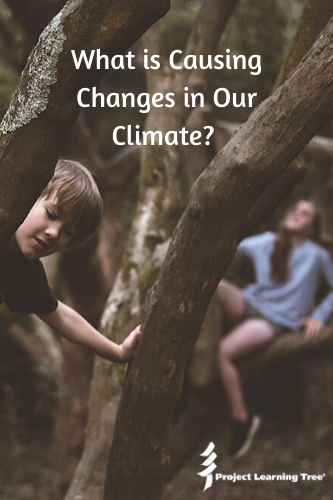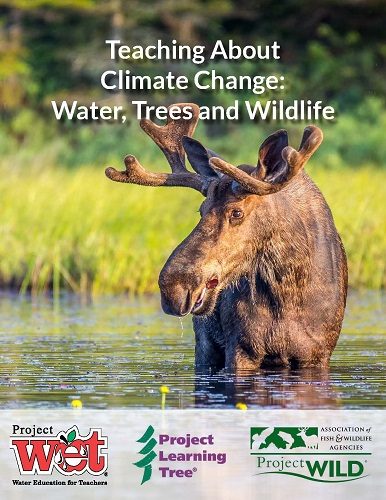 Volcanos, water vapor, landfills, and deforestation all have one thing in common: They can alter the Earth’s temperature. Earth’s natural history gives us evidence that our planet’s temperatures and climate have been fluctuating for millions of years. In recent years, there has been growing concern about rising temperatures across the globe. What is causing these changes in our climate? Why are we so concerned about it now?
Volcanos, water vapor, landfills, and deforestation all have one thing in common: They can alter the Earth’s temperature. Earth’s natural history gives us evidence that our planet’s temperatures and climate have been fluctuating for millions of years. In recent years, there has been growing concern about rising temperatures across the globe. What is causing these changes in our climate? Why are we so concerned about it now?
The Earth’s climate is dynamic, and it is always changing
Throughout history, Earth has endured periods of cooling and warming. The Earth has gone through periods of extreme warming more than once, and most of the Earth’s past was warmer and more humid than it is today.
In Earth’s history, we also know there were periods of cooling. The poles have frozen and thawed and frozen again. One potential cause is large volcanic eruptions that propelled gas and ash into the air. As the particulates in the air block sunlight, less sunlight reaching the Earth’s surface could have caused lower temperatures. Similarly, asteroids hitting the Earth could have sent dust into the atmosphere.
Changes in the Earth’s position relative to the sun can also cause temperature changes. Due to the Earth’s wobble on its axis rotation, its orbit changes slightly, which can affect the planet’s temperature.
During the ice age, glaciers covered most of North America. Since the end of the last ice age (Pleistocene), about 11,700 years ago, the average global temperature has only risen about 5°C (9°F). This shows that even very small temperature changes can have major impacts.
The Earth’s temperature has remained relatively mild and stable over the past 1500 years. Now it seems, the Earth is heating up again. Although the average global temperature has only risen a small amount, eight of the hottest years on record have occurred since 1998. This is concerning many scientists as it supports claims that the Earth’s temperature is currently increasing at an accelerated rate compared to past temperature fluctuations. Is this warming trend just part of some larger natural cycle, or what other things might be contributing to changes in our climate?
Download a free Carbon in Action worksheet.
The effect of greenhouse gases on the Earth’s climate
Greenhouse gases make up a very small fraction of the atmosphere. However, many people are concerned about the effects of greenhouse gases on the Earth’s climate. Just as the glass in a greenhouse traps heat inside the building, greenhouse gases in the atmosphere trap heat around the Earth by absorbing infrared radiation.
Water vapor is the most common greenhouse gas, and it absorbs more infrared radiation than any other greenhouse gas. Higher average temperatures are producing more water vapor and will trap additional heat and result in additional warming. Other greenhouse gases that are of concern are carbon dioxide, methane, nitrous oxide, and ozone. Increasing the concentration of greenhouse gases in the atmosphere causes more heat to be trapped, which could lead to more distinct and dramatic climate changes.
How greenhouse gases enter the atmosphere naturally
There are many ways greenhouse gases enter the atmosphere. Water vapor is the greatest natural contributor to climate change: it evaporates from the water on land and bodies of water, and also from the surfaces of plant leaves during transpiration.
Carbon dioxide is another important greenhouse gas, which can enter the atmosphere naturally through volcanic eruptions. Methane from decomposition and as a by-product of digestion can also contribute to the greenhouse effect.
How human actions contribute to greenhouse gases in the atmosphere
Since the industrial age, human actions have contributed to increased concentrations of greenhouse gases in our atmosphere:
Burning fossil fuels is at the top of the list of human-created greenhouse gases. When fossil fuels (coal, oil, and natural gas) are burned, carbon dioxide is released into the atmosphere.
Agricultural and farming practices also produce greenhouse gases. Agricultural areas that are over-irrigated or flooded create low-oxygen environments, similar to a wetland. These areas produce methane and nitrous oxide, which are also greenhouse gases. Additionally, livestock such as cattle and sheep can produce large quantities of methane.
Landfills that are not properly aerated can also create a low-oxygen environment and produce methane as a by-product.
Deforestation leads to fewer plants and trees that absorb carbon dioxide. In addition, when forests are destroyed by burning, the carbon that made up the trees is added to the atmosphere.
Industrial chemicals that serve as refrigerants (chemicals used in air conditioners, freezers, and refrigerators) are also greenhouse gases. Many of these chemicals were created to replace chlorofluorocarbons, which were destroying the ozone layer. Unfortunately, the new hydrochlorofluorocarbons that we now use are still contributing to rising temperatures.
How a changing climate affects the environment
Changing temperatures impact living things and can have a ripple effect. For example, the timing of plant flowering may be altered by changes in seasonal temperatures, which will impact the behavior of some animals such as bees and other pollinators that many plants depend on to reproduce.
Animals may need to adapt or migrate to more hospitable environments. Plants and some animals, such as slow-moving or stationary animals (coral, for example), do not have the option of moving to more suitable locations, or they may not have the time to adapt to new conditions.
Changes in our environment are also affecting humans. Weather patterns are changing, and natural disasters are more frequent and extreme. Due to rising sea levels, coastal communities and people living on oceanic islands may need to relocate. Diseases spread by organisms, such as malaria, and infectious diseases could spread beyond their current geographic range. Heat waves could cause more deaths to the elderly.
Exploring the causes of rising temperatures
There are many factors that can cause changing climates. With your students, explore all of the potential contributors and how they might be affecting the rising temperatures we have seen in the past few decades. Are humans responsible for the warming trend, or is the warming trend just another natural cycle like other warming and cooling periods the Earth has experienced?
 Here are a few resources to get you started:
Here are a few resources to get you started:
Teaching About Climate Change: Water, Trees, and Wildlife is a reference guide for activities from Project Wet, Project Learning Tree, and Project Wild that can help you explore climate change with your students.
For example, Activity 3 – Is It Only Natural? found in PLT’s Carbon & Climate e-unit helps 6th to 8th-grade students explore factors that have caused climate change in the past, analyze carbon dioxide levels over time, and construct a claim, supported by evidence and reasoning. Unbiased and grounded in scientific facts and winner of a 2020 Teacher’s Choice Award for the Classroom, Carbon & Climate is designed to help students learn how to think, not what to think about this complex issue.
Stanford Earth’s (Stanford University) Climate Change Education website provides curriculum which integrates concepts from the Earth, life, and physical sciences as well as the most current data on climate systems to help students understand the phenomena of climate change, the justification for these phenomena, and why these phenomena are both scientifically and socially important. Middle and High School curriculum are differentiated.
NASA’s website Global Climate Change: Vital Signs of the Planet provides a foundation for studying and assessing global warming. Here you will find data on carbon dioxide concentration, global surface temperature, Arctic sea ice, land ice, and sea level. It includes a section titled “Tips for Teachers” with a 3-page interactive file with step-by-step instructions for using their website in the K-12 classroom.
Climate Kids, also from NASA, is designated for students in grades K-8. Games, activities, animations, and the latest news on climate change are featured in a kid-friendly format.
From PBS Learning Media, check out their Climate Literacy page, featuring public media curated to teach climate science literacy.
Collection of Climate and Energy Educational Resources (CLEAN) is a collection of over 700 free, ready-to-use learning resources that have been rigorously reviewed by educators and scientists. These lessons are suitable for secondary through higher education classrooms.
American Museum of Natural History’s Patterns: Investigating Weather and Climate allows students to look for patterns and connections between weather and climate. The site’s interactive tool allows students to compare variables from multiple locations over different periods of time. They can see how two variables might be related by viewing them on a scatterplot graph.
Also from the American Museum of Natural History, Polar Climate Change Lesson Plans is a curricular unit that helps students explore and understand climate change. These lessons focus on the impact of climate change on the polar regions. Grade levels range from middle school to undergraduates.
Eyes on the Rise is a website that allows students to input their own address and immediately see how far above sea level they are located. This website focuses on student journalism related to environmental impacts related to sea level rise.
Northern Nevada Science Teachers Present: Climate Change Activities for the Classroom was created to aid science teachers in bringing climate change science to their classrooms in an approachable and relevant way. The activities and lessons were written for teachers in Reno, Nevada, but the authors believe that a wider application can be reached in other parts of the country and of the world.


